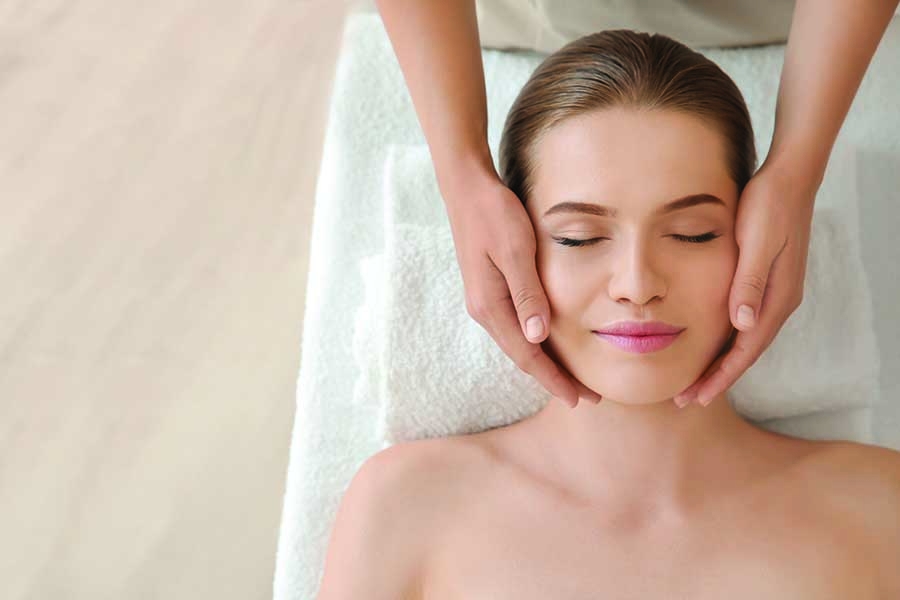A Knead for Release: Eliminating Fine Lines with Massage
Written by by Boldijarre Koronczay and Brian GoodwinPerhaps the greatest connection professionals have with clients in the spa world is their hands. Hands are a tool for massage that can reduce tension, impart a radiant glow to the skin, and rejuvenate the mind, body, and spirit. Many times, clients come into the spa and stress is written all over their faces. Stress increases muscle tension, causing the skin to fold and creating deeper wrinkles and expression lines over time. For both stress and skin aging, massage offers benefits by ironing out wrinkles, stimulating collagen and elastin, and increasing microcirculation and vitality.
Massage has evolved greatly over the years. Therapeutic massage began approximately 4,500 years ago and has expanded into the discovery of facial lifting massage, lymphatic drainage, reflexology, Swedish-style, and other distinguished techniques. For aestheticians, each massage technique can be incorporated into facials to provide better services for clients. With the endless amount of techniques and educational opportunities available in the industry, professionals are merely skimming the surface when it comes to the therapeutic effects and results that can be provided to clients. The true benefits of massage lie in massaging what lies beneath the skin. Most basic massage techniques teach aestheticians to focus on feathery, light relaxation. To boost the benefits of a facial treatment, professionals should dive deeper beneath the skin’s surface.
The skin can be compared to a house structurally. It has a roof (epidermal tissue), framework (dermal tissue), and a foundation (subcutaneous, adipose, and muscle tissues). Most of the basic massage techniques aestheticians and massage therapists utilize, when it comes to the face, focus on relaxation and targeting only the “roof.” However, damage continues from the roof to the foundation. Whether that damage is caused by sun exposure, lifestyle habits, stress, genetics, or aging, using a more active, targeted amount of pressure and focusing on the muscles of the face allow professionals to treat conditions in the skin from the foundation up.
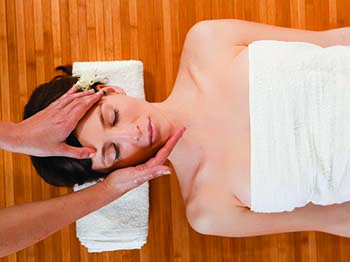
Virtually all facial massages are done while the provider is sitting. Sitting, while generally comfortable and easier, creates many roadblocks for massage. While sitting, pressure must be obtained through professionals straining their own bodies. Many aestheticians and massage therapists suffer from tension, muscle aches, and injuries induced by providing services to clients throughout the years. In addition, getting limbs into position to perform massage techniques while sitting puts the body into harmful and potentially injury-inducing angles. In the sitting position, professionals cannot get a clear view of the client’s facial muscle structure. The face has at least 43 muscles (varying from client to client) and, just like any muscle, these muscles lose tone over time and the foundation begins to slip. When the foundation slips, jowls form, tissue around the eyes loosens, and an overall drooped appearance is created in the entire face.
Healthy body ergonomics – body positioning to support a healthy posture – is crucial to longevity as service providers, and it starts by standing up. Aestheticians do not commonly focus on body ergonomics in their education. Some of the most important points involved with healthy body ergonomics are table height, keeping the back engaged or straight, and utilizing body weight to apply pressure to specific muscle groups. None of this can be achieved while sitting. In clinical studies, sitting has been proven to be unhealthy, with negative effects including exhaustion, hypertension, neck and shoulder pain, and an increase in mortality rates.1 Massage table height should be set so that the hands meet the hips while standing, keeping the back in a healthy position. This allows professionals to rest their body weight on the massage table for support and to utilize body weight for pressure instead of being strained.
The goal while performing massage is to release tension throughout the body. Most massage techniques traditionally taught for facials are focused on the face. While these massage moves are important, the greatest factor professionals need to focus on is the tension that lies everywhere else in the body. If the client has tension in the neck, shoulders, or back, this same tension travels to the face. Without incorporating massage for these areas, estheticians will have an impossible time trying to iron out fine lines and wrinkles or smooth out any other areas the client has concerns with. Tension or pain in the back, neck, and shoulders causes facial muscle contraction primarily through the corrugator (eleven lines), frontalis (forehead lines), and orbicularis oculi (crow’s feet) muscles. In other words, if the muscle is contracted and there is tension, the skin stays folded, no matter how much professionals attempt to smooth it.
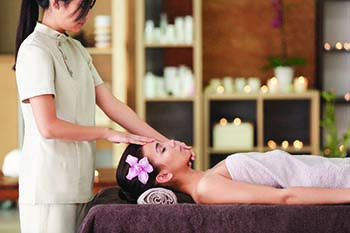
A great starting place in performing massage is the lower back, as this is a common trouble area when it comes to tension. A simple move that can be performed is utilizing body weight to lean into the client’s shoulder from the side of the table, and guiding them into stretching their back to the opposite side. To perform this move, professionals should stand behind the client at the head of the table, and, with the left hand, reach over the client to their right shoulder. Utilize body weight to pull the client’s shoulder towards the head of the table, while rolling the client towards the left side of the table. While supporting the client’s shoulder with the right hand, slide the left hand under their back, moving to the base of the spine, near the lumbar, resting body weight on the table for support. Cup and scoop the hand, moving up the muscles, not the bone, on the right side of the spine. These muscles are known as the erector spinae, rhomboideus major, and serratus posteriour superior muscles. Continue to work with the muscles throughout the shoulder blades, kneading the trapezius and levator scapulae muscles. Repeat these steps three times and then perform the same massage on the opposite side.
These key moves will greatly reduce tension in key areas and set the professional up for success in being able to lift the muscle structure of the face.
Another step that needs to be taken before manipulating the facial muscles is activating the lymphatic system. It is important to encourage drainage before starting the facial. Begin by applying pressure with the fingertips from both hands in the center of the décolleté and push out towards the left shoulder, working below the collar bone and pumping the shoulder down while moving towards the armpit. Do this move six times and repeat on the right side. This pumping action delivers stimulation to one of the main dumping points of the lymphatic system and helps to activate drainage. The lymphatic system functions as the garbage disposal of the body and helps to remove toxins, as well as other waste material. This same system also plays a pivotal role in the body’s immune system, due to white blood cells and other immune cells being created in the lymph. Stagnant lifestyles tend to block the lymphatic system from doing its job. Without regular stretching and exercise, a toxic environment is created in the body. Massaging and activating this system will help to stop clients from feeling sick after intense massage treatments, reduce swelling, and provide an anti-inflammatory effect.
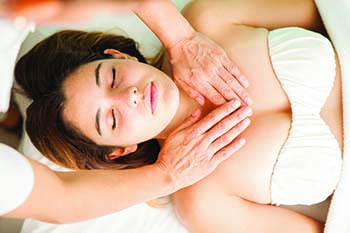
The three areas clients complain about most when it comes to aging in the face are the neck, eyes, and lips. Just light pressure massage by fingertips alone is not enough to affect change within the muscle structure. The typical effleurage motion includes gently stroking the skin of the neck upwards with the fingertips. Instead of using the fingertips, switch to using the whole hand, focusing the pressure on the fat pads of the palms to lift the muscle underneath the skin of the neck, rather than just gently stroking the surface of the skin. The pressure starts at the base of the décolleté and moves up the neck to the jawline. Be careful not to put too much pressure on the larynx or adam’s apple. As these muscles droop, specifically the sternocleidomastoid and platysma, they show up as bands on the front of the neck and clients complain about them. By using this move, clients will see impressive results after one treatment, such as softened fine lines and wrinkles around the neck and décolleté, as well as a tightened, lifted appearance.
The lips are an often-neglected area when it comes to aging – both for professional treatments as well as homecare. That is, until lines develop and clients begin to panic. Interestingly, the muscles around the eyes and lips are not anchored down to bone, tissue, or ligament, so they are free hanging. Gravity’s effect shows up quicker on these muscles and causes them to lose tone more rapidly, creating a drooping effect. Some of the muscles involved are the orbicularis oris, buccinators, and triangularus minor. An effective massage move to press out these wrinkles is to literally iron them out with the thumbs, focusing on the lip line, not the actual lips. Using one thumb, brace the tissue of the lip line while the other thumb presses and flattens out the circular shaped muscle of the lip. This friction-based massage move will help to stimulate collagen, increase circulation, and plump the lips.
The eyes and lips are also the only area of the face with circular shaped muscles. When the orbicularis occuli droops, clients experience bags. This also occurs when the fat pad under the eyes loses shape and cohesion – an often-overlooked factor in wrinkle formation. To give an overall lifted appearance to the eyes, utilize the thumbs to pinch and break down adhesions around the muscle that surrounds the eyebrow – the corrugator muscle. These adhesions can be formed by collagen and elastin fibers the skin cannot break down on its own. These begin to deposit with age and prevent new collagen and elastin creation, accelerating the aging process.
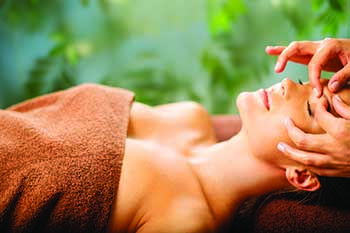
What can clients do after the facial or massage service to continue to see results? Only 20 percent of the results clients see are due to professional service, while the other 80 percent are achieved with consistent use of homecare. In the best case scenario, clients typically only need to see professionals once per month. Twice a day, every day, clients should apply active, healthy, organic skin care to continue the results from the phenomenal treatment provided by professionals. Massage can be used as a tool to sell more products. The hands play a role in growing business and sales by: increasing product penetration, providing better results and increasing client satisfaction; giving facial massages that encourage clients to refer people to the services; and spurring positive feelings in clients. Over 90 percent of clients that come in for any spa treatment are emotional buyers and require an emotional connection to a product or service to be willing to make the purchase. Massage has been proven to release a specific hormone in the body called oxytocin.2 Oxytocin causes a bond to form between professionals and clients, because their stress is eased. This in turn, increases generosity.3 Clients are more likely to rebook, refer others, give increased gratuity, and purchase a product because they associate their massage experiences with positive feelings.
The physical contact professionals have with clients provides a great emotional connection and can help to build relationships in countless ways. The best part is, using the hands more is a built-in, free investment that professionals can make in themselves, by incorporating new massage moves.
Professionals should remember: to maintain healthy body ergonomics while massaging; start by opening and activating the lymphatic system before doing new massage moves; and work with muscle when it comes to massage, not just the surface of the skin. Through continued education in massage and trying new massage moves, professionals will see increased client satisfaction.
References
1 Daneshmandi, Hadi, Alireza Choobineh, Haleh Ghaem, and Mehran Karimi. "Adverse Effects of Prolonged Sitting Behavior on the General Health of Office Workers." Journal of Lifestyle
Medicine 7, no. 2 (July 31, 2017): 69-75. doi:10.15280/jlm.2017.7.2.69.
2 V, Morhenn, Beavin LE, and Zak PJ. "Massage increases oxytocin and reduces adrenocorticotropin hormone in humans." Alternative Methods in Health and Medicine 18, no. 6 (December 2012): 11-8.
3 Zak, P. J., Stanton, A. A., & Ahmadi, S. (2007). Oxytocin Increases Generosity in Humans. PLoS ONE, 2(11). doi:10.1371/journal.pone.0001128
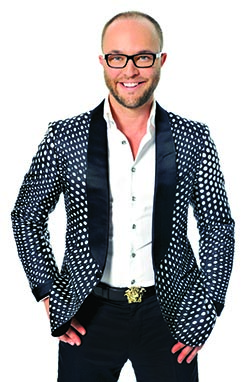
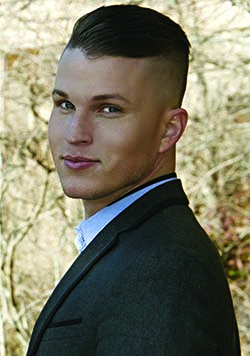 Brian Goodwin is an international educator for Eminence Organic Skin Care. As a master aesthetician, master herbalist, and consultant with over 10 years of experience in the spa industry, Goodwin brings his love and enthusiasm for skin care to the masses with his passionate, fun, and educational trainings. Goodwin has had the honor of educating and consulting over 2,000 distinguished spas and has also been a keynote speaker most notably in New York City, Washington D.C., Los Angeles, and Vancouver, guiding spas towards finding success in both educational and business growth.
Brian Goodwin is an international educator for Eminence Organic Skin Care. As a master aesthetician, master herbalist, and consultant with over 10 years of experience in the spa industry, Goodwin brings his love and enthusiasm for skin care to the masses with his passionate, fun, and educational trainings. Goodwin has had the honor of educating and consulting over 2,000 distinguished spas and has also been a keynote speaker most notably in New York City, Washington D.C., Los Angeles, and Vancouver, guiding spas towards finding success in both educational and business growth.
